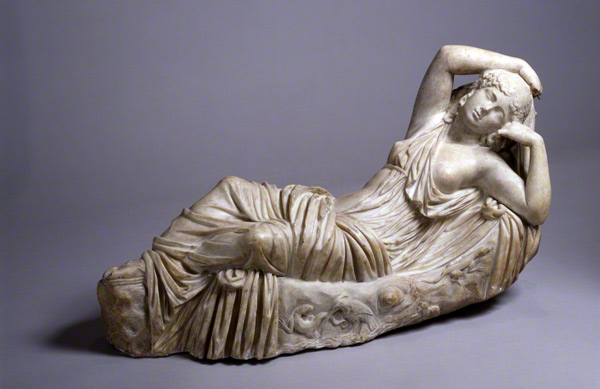Myths and Stories
The artists represented in this exhibition each responded differently to the stories of classical myth and history.
In the 1920s and 1930s Pablo Picasso represented a range of mythological figures, including the Minotaur (a monster, part man, part bull) and Dionysos (god of wine and theater). Francis Picabia created classically inspired figures not tied to specific stories, while Giorgio de Chirico was fascinated by the mythological figure of Ariadne.
In the 1920s and 1930s Pablo Picasso represented a range of mythological figures, including the Minotaur (a monster, part man, part bull) and Dionysos (god of wine and theater). Francis Picabia created classically inspired figures not tied to specific stories, while Giorgio de Chirico was fascinated by the mythological figure of Ariadne.
Picabia's Transparencies
Between 1927 and the early 1930s, Francis Picabia produced a series of works known as transparencies for their layers of superimposed outlines. Allegories without any apparent narrative, the works have seemingly mythical titles that are actually taken from the names of moths and butterflies Picabia found in a zoological guidebook.The three transparencies shown in a group in the exhibition—Salicis (1929), Pavonia (1929), and Rubi (1928–29)—were commissioned by Picabia's dealer Léonce Rosenberg (French, 1879–1947), who engaged several artists to decorate his Paris apartment. Picabia was responsible for Rosenberg's wife's bedroom, and created a number of "allegories" without any apparent narrative. His sources included published illustrations of Roman sculptures, Pompeian frescoes, and Renaissance paintings.
In the transparencies' blend of visual quotations, antiquity was but one period of the past to provide Picabia with ready-made imagery. By 1929 at least four transparencies were installed in the designated room; three hung together on one wall. They are reunited in this exhibition for the first time since the apartment was dismantled in 1932.
De Chirico's Ariadne
The ancient myth of the Cretan princess Ariadne has inspired artists, poets, and musicians from the Renaissance to the 20th century. According to Greek myth, after the hero Theseus abandoned Ariadne on the island of Naxos while she was asleep, the wine god Dionysos found her and married her. In this small Roman version of a Greek statue of Ariadne, the figure rests on a shore populated by lizards, a bird, and a snail.
In 1912–13 Giorgio de Chirico painted nine townscapes centered on a renowned ancient statue in the Vatican Museums of Ariadne sleeping. In two paintings from the series included in the exhibition—The Soothsayer's Recompense and Square with Ariadne—the figure of Ariadne—soon to be awakened by Dionysos—lies in a modern town square as a steam train puffs by in the distance.
For de Chirico, the statue captured the essence of artistic vision, caught between emotional release (embodied by Dionysos) and the calmness of reason (associated with Apollo).
For de Chirico, the statue captured the essence of artistic vision, caught between emotional release (embodied by Dionysos) and the calmness of reason (associated with Apollo).
Artwork images were removed from this page after the close of the exhibition, when the Getty's rights to use them expired.
Publication
Modern Antiquity: Picasso, de Chirico, Léger, Picabia
By Christopher Green and Jens M. Daehner
By Christopher Green and Jens M. Daehner

